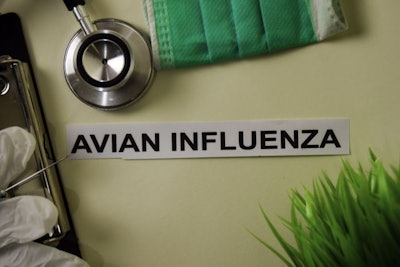
As the number of outbreaks of highly pathogenic avian influenza (HPAI) in poultry continues to rise, authorities in France and England have announced measures to tighten biosecurity on farms, including mandatory housing of commercial poultry.
Also reporting new farm outbreaks have been Belgium, Germany, Italy, the Netherlands, and Poland.
As of October 28, 1,917 HPAI outbreaks have been recorded in commercial poultry flocks across Europe so far this year.
This is based on the latest update of the Animal Disease Information System by the European Commission (EC). To date, one or more outbreaks have occurred in 23 countries covered by the EC since the start of 2022.
With two more months of 2022 ahead, this year’s total well exceeds the 1,756 outbreaks registered with the EC by 24 European states for the whole of last year.
This year, mainland France has reported the most HPAI outbreaks in poultry to the EC (1,386). Next come Hungary (205), Germany (73), and the Netherlands (72).
France introduces special measures for some regions
France raised the HPAI risk level from “low” to “moderate” already at the start of last month.
By mid-October, a sharp increase in HPAI outbreaks was observed in parts of the French mainland. To minimize the spread of the infection, the agriculture ministry announced additional restrictions for the northwestern region of Brittany, Pays de la Loire in the west, and the neighboring department of Deux-Sèvres. Across this “temporary control zone,” it is required that poultry must be housed. Furthermore, testing must be carried out regularly during production, as well as before the birds are moved. Finally, premises may only be restocked following a satisfactory biosecurity audit.
According to the ministry, these measures have met with agreement from the poultry sector. Without full compliance, financial compensation will be reduced for any farms hit by the disease.
Latest data from the ministry put the number of HPAI outbreaks on the French mainland’s commercial farms so far this season at 41 (as of October 28). Premises have been affected in 17 departments.
Over the past 10 days, France’s authorities have officially registered a further five HPAI outbreaks on farms with the World Organisation for Animal Health (WOAH).
Affected were flocks of between 4,200 and 8,050 poultry in five different departments located in four regions. Confirmed in the period October 22-24, the outbreaks all involved the H5N1 virus serotype.
These latest cases bring France’s total outbreaks since November of 2021 to 1,416. Directly impacted through mortality and culling have been more than 16.3 million commercial poultry.
England applies nationwide poultry housing order
From November 7, a national housing order will be in place across England. Announced last week by the agriculture department Defra, this will require all bird owners to keep their flocks indoors, and to comply with stringent biosecurity measures.
With the disease risk raised to “very high,” the latest order extends mandatory housing measures already in place for areas in the east of the country that have already become HPAI “hot-spots.”
“We are now facing this year, the largest ever outbreak of bird flu and are seeing rapid escalation in the number of cases on commercial farms and in backyard birds across England,” said the Chief Veterinary Officer for the United Kingdom (U.K.), Christine Middlemiss. “The risk of kept birds being exposed to disease has reached a point where it is now necessary for all birds to be housed until further notice.
Scrupulous biosecurity and separating flocks in all ways, from wild birds remain the best form of defense. Whether you keep just a few birds or thousands, from Monday 7 November onwards you must keep your indoors. This decision has not been taken lightly, but is the best way to protect your birds from this highly infectious disease.”
Over the past 12 months, the U.K. has been battling the country’s largest ever HPAI outbreak, with cases at more than 200 locations. Since the start of the new HPAI “season” one month ago, the virus has been detected at more than 70 premises.
Covering the period October 6-20, the U.K. authorities have registered 25 new HPAI outbreaks with WOAH involving more than 1.5 million commercial poultry. Almost 30 more confirmed outbreaks — mainly on poultry farms but including also captive birds — have been reported by Defra but not yet registered with WOAH.
Outbreaks elsewhere in European poultry flocks
Over the past 10 days, WOAH has been notified of six further HPAI outbreaks in the Netherlands. Directly affected were almost 540,000 poultry — including broiler breeders and grandparent breeders — in four provinces from Friesland in the north to North Brabant and Limburg in the south of the country.
These latest cases bring to 84 the number of confirmed outbreaks in Dutch poultry flocks over the past 12 months. Just over 4.9 million birds have died or been culled as a result.
Meanwhile, Italy’s poultry outbreaks since the end of September has risen to seven. Around 74,000 birds were affected in the latest outbreaks, which include a first farm in the region of Lombardy. Along with previous cases in Veneto and Emilia-Romagna, this brings the total northern Italian regions affected by the H5N1 virus in the 2022-2023 season to three.
Since the start of this month, HPAI virus-positive results in Germany’s domestic poultry have reached eight, according to the national veterinary reference laboratory, Friedrich-Loeffler Institute. Among these were four in North Rhine-Westphalia, two in Lower Saxony, and one each in Schleswig-Holstein and Bavaria. This latter results appears to be the first in this southern state this season, and the first outside the north of Germany.
Recent notifications have also been received by WOAH from Belgium and Poland. Each has recorded one new HPAI outbreak on a commercial premises during October.
Not covered by the EC disease monitoring system is Russia. However, the national veterinary authority has declared the HPAI situation “resolved” in the Saratov region to WOAH. At a farm in this region of the Volga federal district, the H5N1 virus was detected in mid-August. Affected were almost 132,000 poultry, 33,533 of which died. No further cases have been reported since that time.
More cases among Europe’s backyard flocks, captive birds
In its reporting system, the EC has recently introduced a separate category for HPAI outbreaks in captive birds. Covering non-commercial poultry flocks, zoos, and similar premises, this year’s total stands at 177 (as of October 28).
With 80 so far this year, France leads the region’s nations for this type of outbreak, followed by the Netherlands (44). Each of the 13 other countries reporting cases in this category in 2022 has registered between one and 12 outbreaks.
Since October 22, France has confirmed with the EC five new outbreaks in backyard/captive birds, the Netherlands two, and one each in Belgium, Denmark, and Germany.
Not covered by the EC system, the U.K. has registered three new outbreaks in captive birds to WOAH over the past 10 days.
Among non-commercial poultry and wild birds, Russia notified first outbreaks in the Southern federal district in late May. Following outbreaks affecting more than 9,200 wild birds and 184 backyard poultry, the national animal health agency has declared to WOAH that the situation has been “resolved.”
More wild birds test positive for HPAI Europe
For the year to October 28, a total of 2,864 HPAI outbreaks in wild birds have been reported to the EC. One or more outbreaks have now been confirmed in 32 European states in 2022.
Of the total, 1,151 outbreaks have been reported by Germany, followed by the Netherlands (601) and France (250).
Since October 22, total cases have also risen for Belgium, Croatia, Denmark, Republic of Ireland, Italy, Spain, Sweden and Northern Ireland.
For comparison, the EC disease system recorded a total of 2,437 HPAI outbreaks in captive and wild birds in 31 European states during the whole of 2021.
To WOAH, three nations have declared the disease situation in wild birds closed over the past 10 days. This includes Finland (H5N5 virus serotype), Russia’s Central federal district (H5N1), and Serbia (H5N2).
View our continuing coverage of the global avian influenza situation.

















